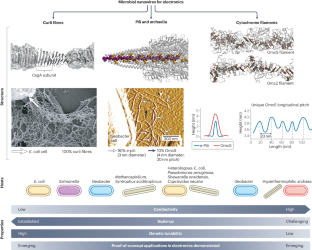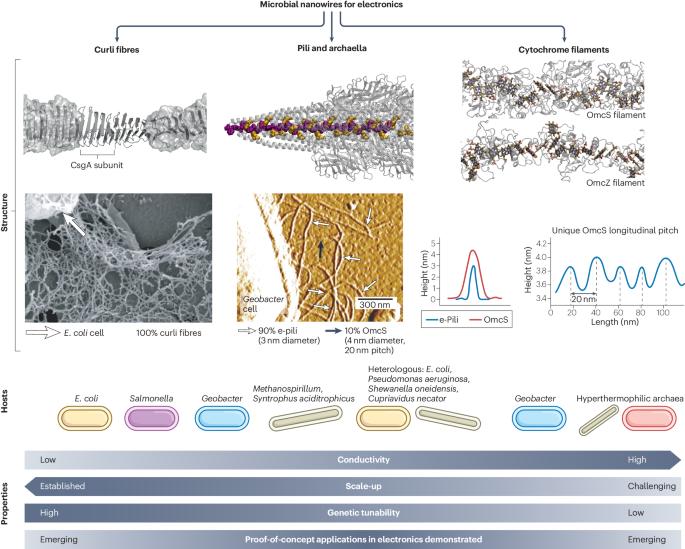Microbial nanowires for sustainable electronics
IF 37.6
引用次数: 0
Abstract
Microbial protein nanowires are emerging as an alternative to abiotic nanowires for electronics applications. Microbial nanowires are sustainably produced, robust, non-toxic, biodegradable and uniquely malleable to precision genetic tailoring, which can confer specific functionalities. At present, the microbial nanowires that seem most adaptable to electronics applications are curli fibres, electrically conductive pili (e-pili) and c-type cytochrome filaments. These nanowires are all highly resistant to conditions that denature most proteins. Editing of the genes encoding curli fibre and e-pili monomers has yielded nanowires with enhanced functions, including increased conductivity, improved sensor selectivity and sensitivity, metal-binding properties, increased surface attachment, and improved nanowire alignment. Such microbial nanowires are highly processable in the organic solvents required for some device fabrication methods and readily incorporated into polymers without loss of function. This Review describes promising electronic devices for sensing, electricity generation and neuromorphic memory that depend on microbial nanowire components and discusses preliminary evidence of the feasibility of other microbial nanowire applications such as transistors, optoelectronics and supercapacitors. Factors that affect the commercialization of microbial nanowire-based electronics are also considered. Microbial nanowires are attractive materials for the fabrication of electronic devices because they are sustainably produced and can be genetically reengineered for a broad range of functionalities. Guberman-Pfeffer and colleagues describe novel devices and mass production strategies that have been demonstrated and outline the optimization strategies required for their commercialization.


用于可持续电子器件的微生物纳米线
微生物蛋白纳米线正在成为电子应用领域非生物纳米线的替代品。微生物纳米线可持续生产、坚固、无毒、可生物降解,而且具有独特的可塑性,可进行精确的基因定制,从而赋予特定的功能。目前,最适合电子应用的微生物纳米线是卷曲纤维、导电纤毛虫(e-pili)和 c 型细胞色素丝。这些纳米线对大多数蛋白质变性的条件都有很强的抵抗力。对编码卷曲纤维和电子纤毛虫单体的基因进行编辑后,纳米线的功能得到了增强,包括增加导电性、提高传感器的选择性和灵敏度、金属结合特性、增加表面附着力以及改善纳米线的排列。这种微生物纳米线在某些设备制造方法所需的有机溶剂中具有很高的可加工性,并且很容易与聚合物结合而不会丧失功能。本综述介绍了依赖微生物纳米线元件的传感、发电和神经形态记忆电子设备的前景,并讨论了其他微生物纳米线应用(如晶体管、光电子学和超级电容器)可行性的初步证据。此外,还考虑了影响基于微生物纳米线的电子产品商业化的因素。
本文章由计算机程序翻译,如有差异,请以英文原文为准。
求助全文
约1分钟内获得全文
求助全文

 求助内容:
求助内容: 应助结果提醒方式:
应助结果提醒方式:


